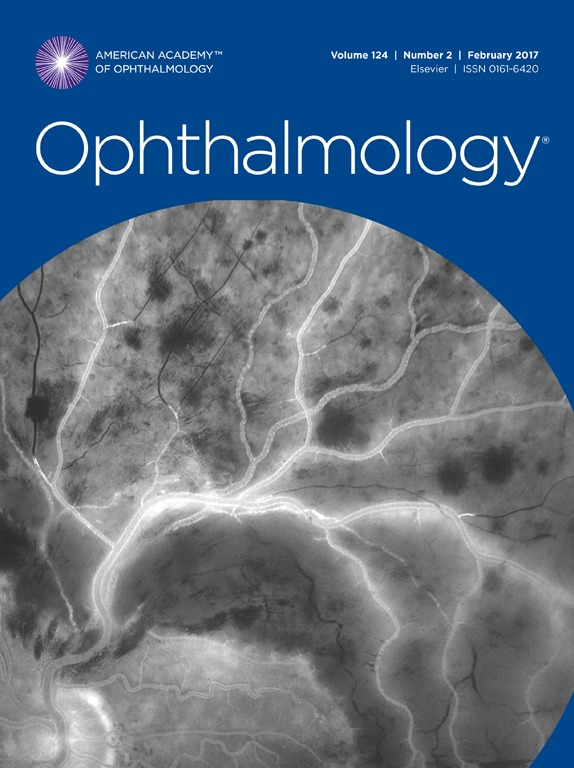掌跖黄斑与血脂异常或心血管疾病无关:病例对照研究
IF 9.5
1区 医学
Q1 OPHTHALMOLOGY
引用次数: 0
摘要
目的在大量人群中确定睑黄瘤(XP)是否与血脂异常、心血管疾病(CVD)和其他系统疾病有关:设计:在一家三级医疗中心进行的病例对照研究:方法:查阅病历,提取有关血脂异常的数据:方法:查阅病历,提取眼科评估、血液检测和系统诊断数据。至少有一只眼睛被确认为 XP 的患者组成研究组。为进行稳健的统计分析,按 10:1 的比例建立了与年龄和性别相匹配的无 XP 对照组:XP与血脂异常和心血管疾病之间的关系。对病例组和对照组的血脂概况、血脂异常诊断和心血管疾病进行比较:数据库包括 35 452 人,其中男性 24 287 人(69%),平均年龄为 52.2±12.2 岁。研究对象包括 203 名 XP 患者(0.6%)和 2030 名匹配的对照组。两组患者的血脂异常诊断率和他汀类药物、纤维素类药物或其他降胆固醇药物的使用率相似。两组之间的血脂状况相似,包括总胆固醇、高密度脂蛋白、低密度脂蛋白和甘油三酯水平的中位数(分别为187名对照组与192名XP组、48名对照组与47名XP组、120名对照组与125名XP组、111名对照组与105名XP组,P均大于0.05)。心血管疾病的发病率也相似(对照组为 10%,XP 组为 8.9%,P=0.56)。包括高血压、糖尿病和脑血管意外史在内的相关疾病的患病率在各组之间相似(对照组 24% 对 XP 组 23%,对照组 14% 对 XP 组 10%,对照组 1.3% 对 XP 组 1%,分别为 P>0.05):XP与血脂异常或心血管疾病发生率增加无关。结论:XP 与血脂异常或心血管疾病发病率的增加无关,这对 XP 作为系统性风险增加的指示性标志物的程度提出了质疑:本文章由计算机程序翻译,如有差异,请以英文原文为准。
Association Between Xanthelasma Palpebrarum with Cardiovascular Risk and Dyslipidemia
Purpose
To determine whether xanthelasma palpebrarum (XP) is associated with dyslipidemia, cardiovascular disease (CVD), and other systemic conditions in a large population.
Design
Case-control study conducted at a single tertiary care center.
Participants
Individuals who were examined at a medical screening institute from 2001 through 2020.
Methods
Medical records were reviewed to extract data on ophthalmic evaluations, blood test results, and systemic diagnoses. Patients identified with XP in at least 1 eye constituted the study group. A control group without XP was established matched by age and sex at a 10:1 ratio to allow robust statistical analysis.
Main Outcome Measures
Associations between XP and dyslipidemia and CVD were determined. Lipid profiles and diagnoses of dyslipidemia and CVD were compared between the case and control groups.
Results
The database included 35 452 individuals, 24 287 of whom were male (69%), with a mean ± standard deviation age of 52.2 ± 12.2 years. The study population included 203 patients with XP (0.6%) and 2030 matched control participants. The prevalence of dyslipidemia diagnosis was similar between the two groups (42% XP vs. 46% controls, P = 0.29), as were the use rates of statins, fibrates, or other cholesterol-lowering medications (48% XP vs. 47% controls, P = 0.88). Lipid profiles were similar between the groups, including total cholesterol (controls median 187 [IQR, 163-211] vs. XP 192 [166-215], P = 0.093), high-density lipoprotein (controls median 48 [IQR, 41-57] vs. XP 47 [42-57], P = 0.65), low-density lipoprotein (controls median 120 [101-141] vs. XP 125 [104-145], P = 0.17), and triglyceride levels (controls median 111 [81-152] vs. XP 105 [81-139], P = 0.16). The rate of CVD was similar as well (10% control group vs. 8.9% XP group; P = 0.56). The prevalences of related conditions, including hypertension, diabetes mellitus, and history of cerebrovascular accident, were similar between groups (24% control group vs. 23% XP group, 14% control group vs. 10% XP group, and 1.3% control group vs. 1% XP group, respectively; P > 0.05).
Conclusions
Xanthelasma palpebrarum was not associated with increased rates of dyslipidemia or CVD. This questions the extent to which XP serves as an indicative marker for heightened systemic risk.
Financial Disclosure(s)
The author(s) have no proprietary or commercial interest in any materials discussed in this article.
求助全文
通过发布文献求助,成功后即可免费获取论文全文。
去求助
来源期刊

Ophthalmology
医学-眼科学
CiteScore
22.30
自引率
3.60%
发文量
412
审稿时长
18 days
期刊介绍:
The journal Ophthalmology, from the American Academy of Ophthalmology, contributes to society by publishing research in clinical and basic science related to vision.It upholds excellence through unbiased peer-review, fostering innovation, promoting discovery, and encouraging lifelong learning.
 求助内容:
求助内容: 应助结果提醒方式:
应助结果提醒方式:


